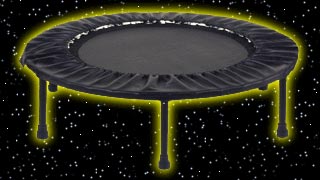Ballistic Impact Ratings:
Ballistic impact on rebounders can go from almost 100% of the ballistic impact removed such as on a bungee rebounder or nearly 80% full on ballistic impact such as on the spring rebounders from sporting good stores that have very few coils and very small diameter.
Note: if you are not doing the Health bounce where you are landing on your heels first for lymphatic drainage or bone density jumping, this page might not apply to you. Most people on the rebounders with high ballistic impact usually end up landing on their toes first so it really doesn't matter but the focus of my site is lymphatic drainage.
Note: Those who are considering bungee type rebounder, the ballistic impact is fine but the inversion is what hurts my knees more than even a 50 dollar rebounder's ballistic impact. This is mainly for rebounders over 40 inches that cone in so buying a bungee thinking that you are going to avoid jarring, make sure you know what you are buying.
The rebounders that give the most bounces per minute from short, low coil springs can feel very jarring if doing high jumping for those that want to do a full workout on them. The Rebound AIR has a very flat feel when jumping from a high bounce and is the most jarring of the rebounders unless ONLY doing the Health Bounce. The Lymphaciser has even smaller springs but they are high carbon and don't have jarring problems unless someone is very over weight. The rebounder that has adjusts to peoples weight is the Cellerciser that has 3 different diameters of spring in each spring.
This is the only one that I've found that doesn't invert or hurt the knees or back.
If the ballistic impact is not high enough such as on a bungee where you have to jump high to get 3 G forces, you don't get the lymphatic drainage that a rebounder that has the maximum bounces per minute you can get based on your weight. (see rebounder weight limits page for heavy people or light people.
Health Bounce and Ballistic impact:
The ballistic impact is irrelevant when jumping high because the body naturally lands on the toes. The ballistic impact I compare between rebounders is when you jump and barely leave the mat. This is how I test it with people of different weights. You want to have the same amount of time on the decelleration as the time in the air. The bungees require way more air time making it impossible for me to consider it for the health bounce. The rebounder that gives the best Health Bounce will give the most bounces per minute with the least ballistic impact. The Lymphaciser gives the most bounces per minute but feels a little jarring with certain weights while the Cellerciser gives the most bounces per minute with a ballistic impact that doesn't jar due to the 3 tiered level of springs. They say it removes 7/8ths of the ballistic impact. The Needak feels almost the same as the Cellerciser but gives fewer bounces per minute as the springs stretch out more. With the Needak, I have to change springs every 2 years to keep the yeild strength close to the yield and tensile strength that their springs have when the rebounder is brand new.
Final note on ballistic impact
If you have not tried the different rebounders on the market, and want help choosing, take my rebounder quiz. If you get a rebounder that is too hard of a bounce or too soft, it will make rebounding not enjoyable. The pain from a jarring rebounder usually doesn't happen on the first time, it is residual over time. A rebounder that has too low or high of ballistic impact for one person might be perfect for another. Take my rebounder quiz.
The Lymphaciser seems to be designed for one type of movement, just the health bounce. Jumping out of the mat based on everyone that has tried it instantly becomes a jarring rebounder but for doing ONLY the Health Bounce, I rate the Lymphaciser the best rebounder out there. (See my Lymphaciser review here).
The Needak and Cellerciser are designed for the Health Bounce and dynamic exercises but the Needak just a little too soft for the Health Bounce for certain weights. (They have a Hard Bounce version for heavier weights but I find I have to know the exact weight of the person to know if it ill give them the maximum bounces per minute. Also considering the yield strength will lessen each 2 years although their springs don't break it can get expensive to keep changing springs.
For those that have a bad back I would choose a spring rebounder over a bungee as jumping very high on a bungee to get the same G force you would get by barely leaving the mat on a spring rebounder, the gentleness can seem like it is no longer there. The bungee rebounder is one that I promote for doing exercise only for the most part. The ballistic impact on a bungee is over a longer peried of time giving it more of a push or thowing you up in the air instead of a sudden pop like on a spring. It's this pop that helps flush the lymphatic system.
If someone gets migraines easily, the ballistic impact from a push type rebounder can put a constant pressure on the head. I try to avoid selling a bungee rebounder to anyone with a bad back or prone to headaches. A good rebounder should allow you to do the Health Bounce without leaving the mat. The lower end the rebounder springs, the higher you have to jump out of the mat to get the same G force with barely leaving the mat.
A good rebounder should help loosen up the joints, NOT jar them. If someone already has knee or back problem, I would avoid the rebounders that don't take out at least 80 to 90% of the ballistic impact. The extra ballistic impact of a rebounder that jars you people don't always feel it at first but after months it can start to impact the joints. I believe the real issue behind joint pain is heavy metals, until they are removed there will probably always be joint problems. If you can't do the Health bounce comfortably on a rebounder, then this will probably never be done.
Out of all the rebounders that people buy who have joint problems, the Needak and Cellerciser are the easiest on the joints. They both have a different feel. The Cellerciser is slightly firmer but it doesn't invert the ankles (pronation of the ankles is practically non existent on the Cellerciser.
The Needak feels softer but it has more decelleration and for people with bad ankles.
The Lymphaciser, forget it, I do not recommend it for someone with joint issues. Way to firm. The Reboundair I have the same issue with. Basically, if someone has weak or painful joints, you don't want a short spring.
If rebounding for lymphatic drainage, which is landing on your heels first and then pushing off with the bar (or toes, which your calve muscles will get sore so you can't do it every day, make sure you get a rebounder that doesn't jar you at the bottom of the bounce. Or worse, invert your ankles so your ankle muscles get sore. Either way, I avoid bungees larger than the Jumpsport mat and rebounders that have that concrete feeling at the bottom of the bounce.
The Lymphaciser, Cellerciser, smallest Jumpsport, and soft bounce Needak are the ones I approve of for this. The Cellerciser is best I have reviewed that ties with the Lymphaciser in certain situations.
If you are prone to headaches or have any neck problems, I strongly urge you to get a soft bounce rebounder like the Needak or Cellerciser if in your budget. The Cellerciser costs more up front but cheaper over time as you don't have to replace springs.
The rebounders I would never use if I have a neck problem or get headaches easily are the Urban rebounder and the Rebound Air if jumping out of the mat. If you are going to get a bungee, the Jump Sport where you can adjust the tension to make it just right is the bungee I would get or a hexagonal type that has the lowest inversion.
The inside of the knee is where most people feel the pain from a rebounder with excess ballistic impact or a bungee larger than the Jumpsport that inverts my ankle.
AVOID RIPOFF: DO NOT BUY ANY REBOUNDER BEFORE READING THIS
Beware of bogus rebounder reviews and fake comparison websites.
See the list of tricks rebounder companies use to trick you here.
Take the
Take the
1-877-354-3778
Open 7am till 11pm Eastern
Lymphaciser
LymphaticRebounding.com
Cellerciser
Bellicon
Needak
Rebound Air
URBAN
Lympholine
JUMP SPORT
Hexagonal
Bungee
Freedom Spring
1-877-354-3778
Open 7am till 11pm Eastern















